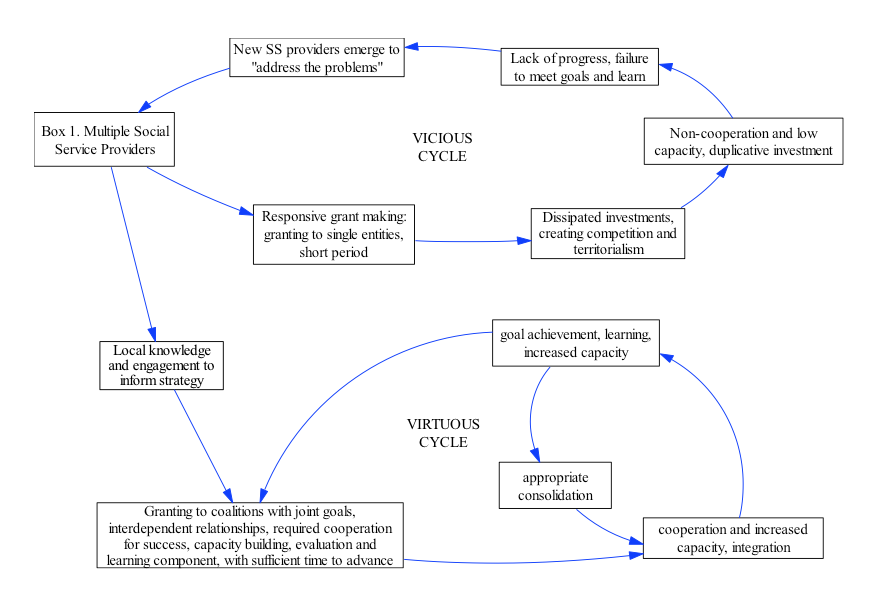
EHF embraces an emerging thread of philanthropy that utilizes strategic planning, evaluation, and learning systems. We want to be accountable for the resources we steward, and we believe communities deserve that kind of accountability. But how does strategic philanthropy differ from non-strategic philanthropy? Let me illustrate with one example.
Some communities despair at the level of social and health problems they face, despite myriad social services agencies serving the local community. What is often not recognized, though, is that it is as critical to know how agencies work together as a system as it is to know who exists and what they do, if we are interested in impact. The system dynamics map below illustrates the role of strategic philanthropy in converting a vicious cycle into a virtuous cycle for advancing community health.

Box 1 is our starting point: a community with multiple social service providers. Upon receiving requests for funding, responsive (non-strategic) philanthropies might provide short-term grants to a number of local agencies working on similar issues. Such grant-making can dissipate investments and create territorialism among agencies. That can lead to lack of cooperation, low capacity, and duplicate investments. The result is failure to meet goals, often with little incentive for improvement. New social services providers emerge to “address the enormous local problems” that have not been solved. But do we question why the challenges are not being met, and what the implications are for how we do things differently, or do we just chalk it up to “need.”
Strategic philanthropy explicitly asks these questions, and recognizes the importance of local knowledge in solving complex problems. Let’s take the same starting point below—Box 1’s multiple social service providers—and consider how a strategic philanthropy approach might transform a vicious cycle into a virtuous cycle for community health. Instead of the responsive grant-making described above, let’s say the philanthropy discovers that the many local social service agencies with similar focus have little incentive to work together.
Philanthropy develops a conversation with the community about key challenges, alignment of goals among agencies, strengths and assets of agencies, and refinement of their roles in implementation. This leads to an application that takes a holistic look at the problem, and advances interdependent relationships, accountability for success, and an explicit learning process for improvement. The result is increased cooperation, capacity and integration among the local players.
Goals are better achieved (or if not, lessons learned for improvement), new structures and relationships might be developed, and agencies may be consolidated, with increased capacity and integration — now we are on to something. In this scenario, we, as a community, fundamentally changed the dynamic and the systems structure to better respond to local problems because we took a strategic approach. Of course, some social service providers have been trying to tackle such cycles for quite some time, but have not had the resources, leverage, or partners to effectively do so. Philanthropy can be one of those partners for transforming vicious into virtuous cycles and beginning to address complex social problems.

What do you think of strategic philanthropy approaches? Does this level of philanthropic engagement with communities make sense to you? Do you think that systems approaches can help us make a difference together in advancing community health transformation?